BY BEN PEETZ
As a classic cartoon often reminded us, “Knowing is half the battle.” And yet, when we look at manufacturing and industrial facilities, many fire departments know nothing about what to expect when it comes to responding to a fire in these properties in their first-due area. Obviously, making regular on-site inspections along with comprehensive preplanning offers you the best means of knowing what you have before you head into it. Unfortunately, limited resources or staffing issues prevent many departments from maintaining these types of programs on a consistent basis. This is the time you must be able to figure out what you have through cues and clues obtained during preincident drive-bys and on-the-fly during a response.
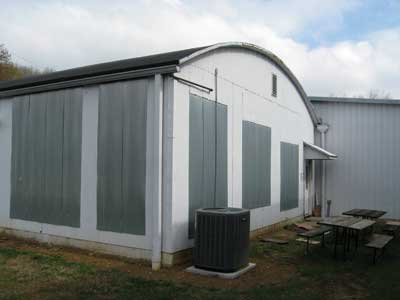 |
| (1) Not only can the construction for manufacturing facilities vary widely, but some buildings may be repurposed from the original design based on changes to the interior operations. Here, a bow-truss section of the building has had the windows closed off with metal siding, thus reducing natural ventilation and potentially contributing to more buildup of heat and earlier collapse of the bow-truss construction. (Photos by author.) |
Whether you obtain your information during preplanning activities or a response, much of the approach is the same. Good background knowledge coupled with careful observation will give you much to work with to keep you and your crew safe and effective during an incident. To learn and maintain these types of skill sets, fire and emergency medical services often use analogies and abbreviations to help them remember key points. Although the alphabet soup can sometimes get confusing, most find it very helpful when it comes to remembering the steps needed to make a great save.
At my FDIC 2011 classroom session, I introduced a new spin I developed on the classic COAL TWAS WEALTHS memory tool for scene size-up. The mnemonic device “CODE PURPLE” can assist you in remembering some of the key aspects for preplanning size-up as they relate to industrial and manufacturing occupancies.
“CODE PURPLE”
“CODE PURPLE” relates to preplanning and size-up characteristics as follows:
• C—CONSTRUCTION: In more than one way, construction is the first characteristic that you must look at when responding to an industrial or manufacturing facility. But in these cases, you need to look at not only the construction materials used but also the architecture and engineering of the structure. This could be as simple as recognizing bow-truss construction from the outside or realizing that such a roof structure may be partially hidden from view by a façade.
Fire departments with century-old multistory buildings must have an understanding of what heavy timber construction is and how fire affects it. And yet others must understand how heat affects heavy steel roof decks constructed on tilt-up concrete walls. Beyond the building itself, you then need to look at interior construction. Are there steel decks and mezzanines, or will you find that there have been offices and storage rooms constructed of wood frame? Construction, both exterior and interior, is an integral component in determining how you will look at every other element of your response to an industrial or manufacturing facility.
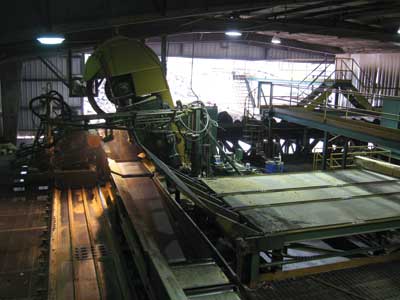 |
| (2) Some occupancies present challenges for containment and confinement. In this sawmill, the open end of the building will allow uncontrolled ventilation of a fire, and the open grates and equipment will allow fire to drop to various levels through the mill structure. |
•O—OCCUPANCY: This is where you need to figure out just what is inside the building. When you respond to a standard room-and-contents fire or even a fully involved residential structure, you have a reasonable idea of what you expect will be involved in that fire. However, when it comes to manufacturing and industrial occupancies, the same space within a typical building could be occupied by any number of things.
 |
| (3) Even a small fire seemingly contained to a hydraulic unit could quickly spread if burning debris drops through the open grate flooring and ignites material under work platforms and mezzanines. |
In recent years through my job as an insurance fire protection specialist, I have looked at many buildings across the Midwest that have changed hands a number of times. And each time a building changes ownership, the occupancy of that structure may change significantly. In Indiana, I know of a sawmill that is housed entirely within a building where electric motors were once manufactured. In Illinois, there is a housing components plant inside a building that once was home to a large aviation equipment manufacturer. And not only that, but today’s technology and processes change so quickly that a given space within a particular company’s plant may not house the exact same process or equipment more than a few years or perhaps months, even if the ownership remains consistent.
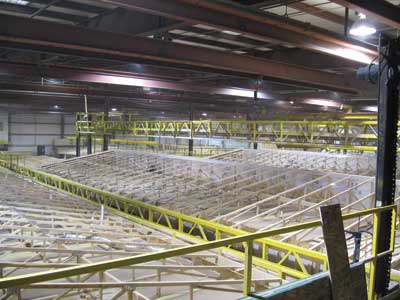 |
| (4) Knowing the occupancy of a building is critical to managing the fire response. Plants that manufacture mobile homes and recreational vehicles may have many units in varied states of progress throughout a facility, creating actual structure fires within a larger structure. |
And what about occupancies that you may think you know? I once worked with a large hobby supplier whose massive distribution warehouse included a very large bulk storage room for its high-octane model airplane fuels. Areas within a given facility may present entirely different scenarios for a fire response based solely on the process or materials in that space.
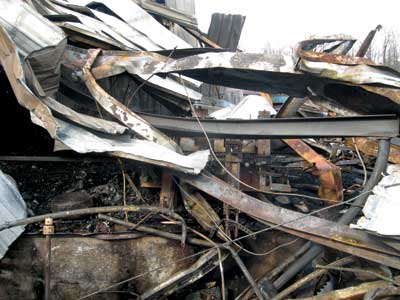 |
| (5) Although noncombustible construction is often insured as being less of a fire risk than wood-frame buildings, its end result in a fire is still often a catastrophic loss. Just because the construction materials may not contribute to the fire loading, a building collapse is still very common with fires in steel-frame buildings. |
•D—DEMANDS: In the movie “City Slickers,” the character played by Billy Crystal talks about that “one thing” that is most important in life and how that single thing is different to every individual. Take the same approach here. This is where you will need to decide what a fire response to this facility will demand, especially in terms of actions above and beyond a standard response:
- Will you need a larger water supply than usual?
- Do you have mutual aid available? Will you need additional alarms right away, or can you investigate first?
- Will you need emergency management or environmental personnel?
Many of the response demands will be developed as you look at all of the other elements. Maybe it simply involves special procedures your department and personnel will use to access a fire situation at this facility. I know several departments that use special high-rise packs of hose that are premeasured and packaged for deployment into specific facilities or areas of facilities where they can expect a fire response will be needed.
• E—EXPECTATIONS: Once you have a good handle on what the facility is, you can begin to gather your expectations of what you will find. Try to look at manufacturing and industrial properties from the angle of “when” it burns, not “if” it burns. Expect a fire. What do you expect from them before things go wrong? And what can you expect when things DO go wrong? Does this facility have a fire brigade, or does its policy direct employees to do nothing more than evacuate? And how will the occupancy of the fire area affect your expectations? But be careful even when you think you know what you have.
Occupancies within a similar class can produce far different expectations. For example, a case goods furniture manufacturer may have combustible dust-collection systems and solvent-based spray finishing. On the other hand, you can reasonably expect an upholstered furniture manufacturer to have extensive amounts of foam rubber and plastics, which would produce thick, black smoke. An overall approach should be to have an idea of how the things within the facility will affect a fire situation, and this should play into your developing specific tactics for response. For the most part, every individual thing that exists or goes on within a facility will affect a fire in one of four ways: (1) causing a fire, (2) making a fire greater, (3) making a fire smaller, or (4) preventing a fire.
 |
| (6) The storage configuration for a particular product may contribute greatly to the amount of risk associated with a fire. In the case of “stickered” lumber, the fuel load is arranged with a great amount of air entrained within the product, so a small fire could quickly grow out of control. This is especially important in a situation like this, where committing an apparatus to a limited clearance area could quickly turn catastrophic. |
• P—PROTECTION: A look at protection accounts for all of the elements in place to stop an active fire, both the systems you hope will automatically work to protect the property from fire as well as those resources you will need to make your response effective.
- First, know what resources are on-site or readily available for use in fire suppression.
- Where is the water supply going to come from? Do you have an adequate and reliable municipal water supply? Are hydrants available and in locations that are accessible? Is there a water tank or fire pond at the location? Will you need to understand and work with a fire pump system? Do you instead need to rely on a static supply or perhaps establish tanker shuttles?
- What about systems in place before you arrive? Does this property have any automatic fire protection, ranging from water-based sprinklers to other suppression systems, like clean-agent or wet-chemical systems? If there are automatic sprinklers, do you know if they are properly designed for the occupancy? Do you know if automatic systems are well maintained, and do you expect them to be reliable?
The answer to each one of these questions can have a significant bearing on your tactical approach.
• U—UNAFFECTED PROPERTY: With manufacturing and industrial facilities, especially those that cover a large footprint or consist of numerous buildings, a primary approach may be to limit the loss and contain it to the immediately affected area. You may have systems in place prior to your arrival designed to stop extension of the fire into the initially unaffected portions. Fire walls, fire doors, and ventilation dampers are all ways of limiting fire growth and spread, but you must also consider the ways they will restrict your access to a fire. Without keeping these things in mind, your suppression efforts could be delayed and in some cases put personnel in danger.
Fire doors will slow the spread of fire, but they will also cut off access to the fire, and if fire personnel enter before the door is activated, they may cut off an exit and supply line, trapping firefighters.
There are also fire situations where you should immediately recognize the need to sacrifice some property to make a bigger save. This may involve actions like cutting corridors, breezeways, or ducting to limit fire spread.
A lumberyard I work with in northern Indiana suffered a massive fire in 1997, prior to the facility’s having automatic sprinkler protection or an adequate water supply. After the initial defense of exposures proved ineffective, the fire department finally realized the need to actually push the lumber INTO the fire so that a fire break could be established to stop the spread. This action ended up slowing the spread and eventually helped to save several other structures at the location.
• R—RAW MATERIALS: As I mentioned earlier, look at the structures themselves as well as what is in them. Manufacturing and industrial processes could potentially involve any number of raw material substances, from wood to flour to plastic to aluminum. Although tank farms and other liquid-intensive operations present challenges well beyond the scope of this discussion, with general industry occupancies, you must still consider the potential for bulk tank storage of resins or solvents used during a manufacturing process. This could include anything from metal powder coating to fiberglassing to furniture finishing as well as any facility that stores or consumes fuels or lubricants in bulk. Obviously, each material will burn differently, presenting different challenges and tactical needs.
However, not only must you take into account the material itself, but the size, shape, and form of the material also may drastically affect a fire situation. Aluminum wheels may not pose much of a fire load in finished form, but a fire in an aluminum machining area could prove deadly if combustible dust ignites or explodes. Combustible dust is just one example of how an otherwise noncombustible material like aluminum can suddenly produce an unexpected, even deadly, situation. Other products like foam rubber and plastic pellets may produce thick, black smoke. Even so-called flame-retardant foams can smolder and smoke, causing issues with locating the seat of a fire.
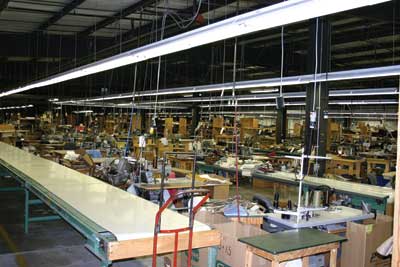 |
| (7) Manufacturing facilities are often very busy in terms of furnishings, fixtures, and utilities. Not only can the furnishings at ground level create serious challenges for accessing a fire area, but equipment and materials suspended overhead can cause danger to firefighters entering the area. |
• P—PROCESS HAZARDS: Before you send a crew into one of these facilities, you absolutely must have some idea of what they are getting into. Understanding the processes and equipment and how the materials are handled is critical to effective response and firefighter safety.
For most facilities, begin your basic hazard assessment with a look at where the highest volume use of utilities exists, including electric and natural gas.
The next concern should be an overall consideration for equipment, including anywhere there is extensive use of hydraulics and lubricating oils as well as thermal transfer fluids for heat processes. Other processes presenting higher hazard situations include flammable finishing processes, fiberglass layup, and anything involving combustible dust. Combustible dust issues have garnered a great deal of attention in recent years. You must address a fire in a silo or dust collection unit in a way that does not promote the possibility for explosion. Any areas where machining, grinding, sanding, or other processing of materials takes place present potentially dangerous scenarios.
When looking at equipment, be sure to identify your “no-man’s-land” areas within a facility based on the potential for injuries from process hazards. Some areas must be identified as off limits in all instances. This should particularly include places where stored energy cannot be isolated. Most facilities should be able to provide you with a copy of their Occupational Safety and Health Administration Lock-Out, Tag-Out (LOTO) program, which will help you identify areas where energy must be isolated before personnel can safely enter the areas. Bear in mind, however, that a LOTO program is designed for the daily work environment, and fire conditions may change the situation by compromising the integrity of the equipment or by presenting other challenges and dangers not accounted for in the facility’s plan.
• L—LEVELS OF INVOLVEMENT: In industrial and manufacturing facilities, the movement between levels within the building is much more likely and much less easily predicted than it might be in a residential structure. Without some idea of the interior makeup of the plant, you may quickly find yourself chasing your tail in terms of getting control of a rapidly spreading fire. Because many of these plants may incorporate the use of mezzanines or multilevel work platforms, a rapidly spreading fire may be difficult to control without using the features of the structure.
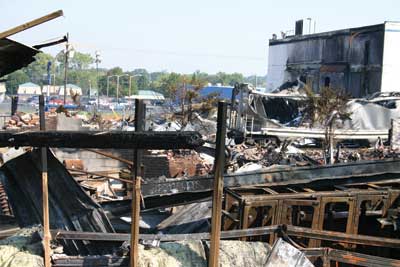 |
| (8) In the case of this plastics factory fire, part of the fire load included rail cars loaded with plastic pellets. The building on one side of the tracks ignited the rail cars, which in turn created enough heat to inhibit protection of the exposure across the track. Know what to expect if a particular facility is involved in fire, and consider how you may be able to move mobile equipment or remove some of the materials that will contribute to a fire’s growth and spread. |
I once toured a fiberglass operation that uses a special high-elevation process that helps use gravity for lamination; however, this means fiberglass mixing and application are taking place at multiple levels from the ceiling work deck almost 10 stories above all the way down to the ground floor with combustible materials hanging in suspension from floor to ceiling. A fire in such a facility will certainly travel upward and into the superstructure of the building, but have you considered where burning debris may fall and how it could injure or kill firefighters? At the very least, always consider falling debris from the perspective of causing ignition in the lower levels of a facility.
Another example would be a fire in a sawmill hydraulic unit. This may not initially be a serious incident, but if fire spreads and drops through open-grated floors into the lower levels of the mill, a large fire could quickly engulf areas where sawdust and scrap materials are collected. At this point, even if conveyors and other equipment are properly shut down, a fire could quickly spread to much of the facility if these areas are not secured. Now, consider what happens if a dust collection system draws that same fire into a filtration unit or silo. In these types of facilities, you must consider just how the hazards can quickly spread and escalate beyond control.
• E—END PRODUCTS: Every manufacturing and industrial facility produces some sort of end product. Do you know what this plant is producing and how it is stored for distribution? Is this facility producing a raw material that will go into another process in another location? How volatile to fire is the end product itself?
Even the storage arrangement of the product is important. For instance, the volatility of lumber can be greatly affected by how it is stacked. Packaged lumber for shipment is densely packed and will not burn easily, whereas “stickered” lumber has slats placed between the layers of lumber to allow for air flow. In this configuration, the lumber will burn rapidly and intensely.
Pallets are produced with dry lumber, which will burn with extreme intensity. Perhaps this plant produces some type of combustible widget that presents additional fire loading.
Then consider the packaging and crating. Maybe the product itself is not a concern, but if it is being crated on combustible pallets stacked 30 feet high, this presents some serious firefighter safety concerns. Much of this reasoning has been applied in the development of the National Fire Protection Association commodity classes for warehouse storage. I have walked through warehouses filled with steel and aluminum automotive wheels stacked to the ceiling in wooden or plastic crates. If the wooden crating begins to burn, how long until the stacks start to collapse? If the plastic begins to burn and produces a thick, black smoke, will your firefighters be able to recognize a potential collapse resulting from compromised skids?
Also consider the size of the units being produced. Have you ever fought a vehicle or house fire inside of another building? This is exactly what departments that respond to recreational vehicle or manufactured housing plants must be ready to do.
Through the use of proper preplanning and size-up, fire departments with industrial and manufacturing properties within their first-due areas can more safely and effectively respond to a fire. The key component is information. Although it can be very helpful, a complete working knowledge of every intricacy of a facility is certainly not necessary. For the most part, ensure that you have some idea of what goes on inside that plant instead of driving by it every day knowing nothing more than “someday that fire will be a big one.”
● BEN PEETZ, ASP, CFPS, is a senior loss prevention specialist and fire protection consultant for Lumbermen’s Underwriting Alliance, a commercial property insurance carrier specializing in forest products and other manufacturing industries. He is a second-generation fire service veteran with the Napoleon (IN) Volunteer Fire Department, where he has served nearly 20 years. Peetz is an IFSAC-certified fire instructor II/III and a Fire Department Instructors Conference instructor. He is a National Fire Protection Association certified fire protection specialist and a Board of Certified Safety Professionals associate safety professional. He has degrees from Purdue University.
More Fire Engineering Issue Articles
Fire Engineering Archives

